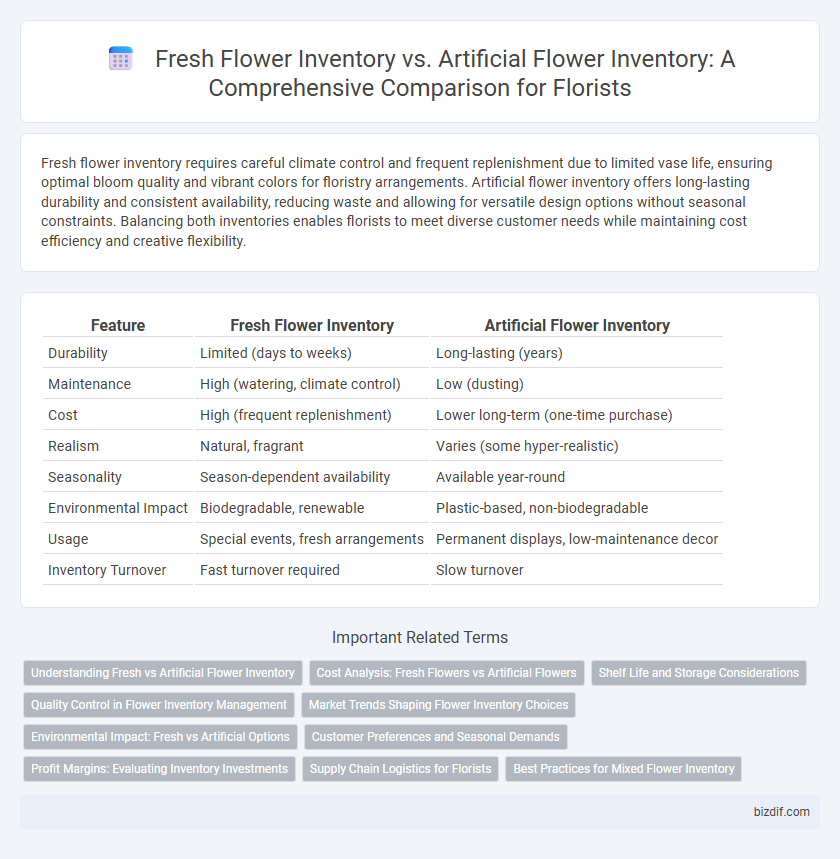Fresh flower inventory requires careful climate control and frequent replenishment due to limited vase life, ensuring optimal bloom quality and vibrant colors for floristry arrangements. Artificial flower inventory offers long-lasting durability and consistent availability, reducing waste and allowing for versatile design options without seasonal constraints. Balancing both inventories enables florists to meet diverse customer needs while maintaining cost efficiency and creative flexibility.
Table of Comparison
| Feature | Fresh Flower Inventory | Artificial Flower Inventory |
|---|---|---|
| Durability | Limited (days to weeks) | Long-lasting (years) |
| Maintenance | High (watering, climate control) | Low (dusting) |
| Cost | High (frequent replenishment) | Lower long-term (one-time purchase) |
| Realism | Natural, fragrant | Varies (some hyper-realistic) |
| Seasonality | Season-dependent availability | Available year-round |
| Environmental Impact | Biodegradable, renewable | Plastic-based, non-biodegradable |
| Usage | Special events, fresh arrangements | Permanent displays, low-maintenance decor |
| Inventory Turnover | Fast turnover required | Slow turnover |
Understanding Fresh vs Artificial Flower Inventory
Managing fresh flower inventory requires precise tracking of bloom lifespan, storage conditions, and supplier schedules to minimize spoilage and maintain product quality. Artificial flower inventory emphasizes durability, reusable stock, and seasonal design updates, reducing waste and ensuring consistent availability. Understanding these differences allows florists to optimize stock levels, meet customer preferences, and control costs effectively.
Cost Analysis: Fresh Flowers vs Artificial Flowers
Fresh flower inventory requires continuous replenishment due to perishability, leading to higher recurring costs including refrigeration and waste management, whereas artificial flower inventory involves a larger upfront investment but minimal ongoing expenses. Cost analysis reveals that fresh flowers typically have a higher price per unit but offer superior customer appeal for ephemeral events, while artificial flowers provide long-term savings and durability for permanent displays. Evaluating overall profitability must consider factors such as turnover rate, storage requirements, and the target market's preference for natural aesthetics versus budget constraints.
Shelf Life and Storage Considerations
Fresh flower inventory requires cool, humid storage conditions to maintain optimal shelf life of typically 5 to 14 days, with careful monitoring to prevent wilting and mold. Artificial flower inventory offers significantly longer shelf life, often years, with minimal storage needs, primarily requiring dust-free, dry environments. Efficient inventory management in floristry balances the perishability of fresh flowers against the durability and low-maintenance storage of artificial alternatives.
Quality Control in Flower Inventory Management
Effective quality control in flower inventory management ensures fresh flowers maintain optimal bloom, fragrance, and longevity through regular inspections, temperature regulation, and proper hydration. Artificial flower inventory demands consistent quality checks for colorfastness, material durability, and realistic appearance to meet customer expectations and reduce returns. Balancing these quality control measures minimizes waste, maximizes customer satisfaction, and streamlines inventory turnover in floristry businesses.
Market Trends Shaping Flower Inventory Choices
Market trends in floristry reveal a growing preference for fresh flower inventory driven by consumer demand for natural, fragrant, and biodegradable options, enhancing eco-conscious brand appeal. However, artificial flower inventory remains significant within the market due to advancements in realistic designs, durability, and cost-effectiveness for long-term displays and events. Seasonal fluctuations and sustainability concerns further influence florists to strategically balance fresh and artificial flower stocks to optimize inventory turnover and meet diverse customer preferences.
Environmental Impact: Fresh vs Artificial Options
Fresh flower inventory typically has a lower carbon footprint due to its biodegradable nature and reliance on natural growth cycles, whereas artificial flower inventory involves plastic production and synthetic materials that contribute to long-term environmental pollution. Growing fresh flowers requires water and pesticides, but their decomposition and composting minimize landfill waste, contrasting with artificial flowers which persist in the environment for decades. Biodegradability and renewable sourcing give fresh flowers a significant edge in sustainability compared to the fossil-fuel-based raw materials used for artificial flowers.
Customer Preferences and Seasonal Demands
Customer preferences between fresh flower inventory and artificial flower inventory vary significantly, with fresh flowers preferred for their natural fragrance and vibrant appearance, especially during peak seasonal events like weddings and holidays. Seasonal demands heavily influence fresh flower availability and pricing, necessitating careful inventory management to meet fluctuations in consumer interest, whereas artificial flowers offer consistent availability and longer shelf life regardless of season. Florists optimize inventory by balancing the allure of fresh blooms with the reliability and cost-effectiveness of artificial flowers to capture diverse market segments.
Profit Margins: Evaluating Inventory Investments
Fresh flower inventory typically offers higher profit margins due to premium pricing driven by quality and freshness, but it demands faster turnover to avoid spoilage and losses. Artificial flower inventory involves lower upfront costs and longer shelf life, enabling more flexible sales timelines but often yields moderate profit margins due to lower perceived value. Strategic inventory investment balances these factors by maximizing fresh flower sales during peak seasons while leveraging artificial flowers for consistent year-round revenue.
Supply Chain Logistics for Florists
Managing fresh flower inventory requires precise temperature-controlled storage and expedited transportation to maintain bloom freshness and extend shelf life, making supply chain logistics complex and time-sensitive. Artificial flower inventory benefits from longer shelf stability and less stringent shipping conditions, allowing for bulk purchasing and simplified warehousing that reduces overall logistics costs. Florists must balance these factors by optimizing inventory turnover rates and leveraging reliable suppliers to minimize waste and meet fluctuating customer demand.
Best Practices for Mixed Flower Inventory
Maintaining a mixed flower inventory requires balancing the perishability of fresh flowers with the durability of artificial blooms to optimize stock turnover and reduce waste. Implement best practices such as categorizing inventory by type, monitoring freshness daily for fresh flowers, and using climate-controlled storage to extend shelf life. Digital inventory management systems enable real-time tracking, ensuring timely restocking and minimizing overstock of artificial flowers while capitalizing on their long-lasting appeal.
Fresh flower inventory vs artificial flower inventory Infographic

 bizdif.com
bizdif.com